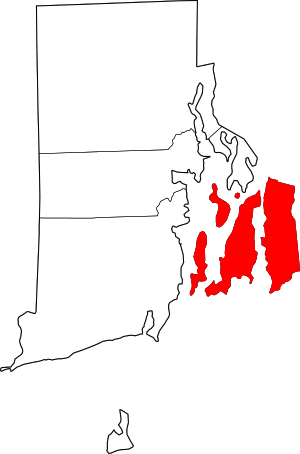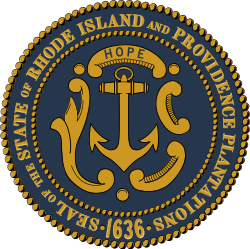Little Compton, Rhode Island
Little Compton is a coastal town in Newport County, Rhode Island, bounded on the south by the ocean, on the west by the Sakonnet River, on the north by the town of Tiverton, and on the east by Massachusetts and the town of Westport.
Little Compton, Rhode Island | |
|---|---|
Town | |
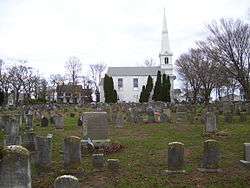 Town Common | |
Location of Little Compton in Newport County, Rhode Island | |
| Coordinates: 41°30′N 71°10′W | |
| Country | United States |
| State | Rhode Island |
| County | Newport |
| Settled | 1675 |
| Incorporated | June 6, 1682 |
| Annexed by Rhode Island | January 27, 1747 |
| Government | |
| • Type | Town Council-Town Administrator |
| • Town Council President | Robert L. Mushen (R) Gary S. Mataronas (R) Paul J. Golembeske (R) Lawrence G. Anderson (D) Andrew W. Moore (D) |
| • Town Clerk | Carol A Wordell (R) |
| • Town Administrator | Antonio A Teixeira |
| • Town Moderator | Scott A Morrison (R) |
| Area | |
| • Total | 28.9 sq mi (74.9 km2) |
| • Land | 20.9 sq mi (54.1 km2) |
| • Water | 8.0 sq mi (20.8 km2) |
| Elevation | 104 ft (25 m) |
| Population (2010) | |
| • Total | 3,492 |
| • Density | 167.1/sq mi (64.5/km2) |
| Time zone | UTC–5 (Eastern) |
| • Summer (DST) | UTC–4 (Eastern) |
| ZIP Code | 02837 |
| Area code(s) | 401 |
| FIPS code | 44-42400[1] |
| GNIS feature ID | 1220062[2] |
| Website | Town website |
The town clings to the past just as it clings to the coast. Little Compton's remote physical isolation, bordered by water on two sides, has left the locale relatively unchanged by late 20th century urban sprawl. A visit to Little Compton is like stepping back in time to pre-war New England. An abundance of historic architecture nestled in its well preserved rural landscape evokes early 20th century America. There are no stoplights or four way intersections. Of the few roadside businesses, most have gravel parking lots rather than asphalt, and the town bans plastic signs. Sleepy, sunlit summer days bring antique vehicle collectors out onto the roadways, as if time stands still.
History
Little Compton was originally inhabited by the Sakonnet Indians. The name has been interpreted in a variety of ways including "where the water pours forth". The first Colonial settlers in Little Compton were from Duxbury, Massachusetts in the Plymouth Colony, which granted them their charter. They divided the land into standard-sized lots and settled there. Among these 29 original proprietors was Colonel Benjamin Church, who would become well known for his role in the late 17th-century conflicts with surrounding Indian tribes, initially the Wampanoags and later, the Narragansetts. In 1675, Church built a house in Little Compton, just prior to King Philip's War. Today, a plaque marks the location on West Main Road.
In 1682, Sakonnet was incorporated by the Plymouth Colony and was renamed Little Compton, probably in reference to Cullompton, Devon, England. After the "Old Colony" was merged into the Massachusetts Bay Colony to the north, a local colonial representative to the General Court in Boston boasted that all the stone walls in Little Compton would stretch to the State House and back, if laid end to end. A Royal commission changed the state border in 1747, and Little Compton along with Tiverton and Bristol became part of Rhode Island. All probate and land records prior to 1746 are kept in Taunton and New Bedford, Massachusetts. Beginning in the late Victorian era, the town became a destination for summer visitors drawn to its beaches and farms seemingly untouched by modernity, and for its relatively cool, maritime climate.

Sites of historic interest in Little Compton include the Wilbor House, built in 1692 by Samuel Wilbore and now the home of the Little Compton Historical Society.[3] The entire town commons is listed in the National Register of Historic Places. There are about 57 historic cemeteries in the town. Benjamin Church and his family are buried in the Little Compton Commons cemetery, as is Elizabeth Pabodie, the eldest daughter of John Alden and Priscilla Mullins of Mayflower fame. The stones in the cemetery reflect a style of carving similar to that found both in Newport and in Boston during the same time period.
Little Compton is home to one of only three town commons in Rhode Island. The others are in Bristol and Warren. Land for the common was designated in August 1677 and has been used ever since as both a religious and civic center, the location of churches, a school, the town hall, town library, and other government buildings and civic institutions. The Commons contain a large cemetery.[4] The Commons and other town owned properties are described in the essay, "In Search of the Commons" by Steven Lubar of The Little Compton Historical Society.[5]
Another distinctive feature of the town is the circa 1905 "Spite Tower" found in the hamlet of Adamsville. Built as a water tower, local lore claims that it was constructed to obscure the sightlines of a rival abutting neighbor.
Fort Church was built near Sakonnet Point during World War II and was named for Benjamin Church. The largest of the four batteries was Battery Gray with two 16-inch guns, an area that became the Sakonnet Golf Club.[6]
Demographics
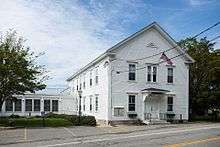
| Historical population | |||
|---|---|---|---|
| Census | Pop. | %± | |
| 1790 | 1,542 | — | |
| 1800 | 1,577 | 2.3% | |
| 1810 | 1,553 | −1.5% | |
| 1820 | 1,580 | 1.7% | |
| 1830 | 1,378 | −12.8% | |
| 1840 | 1,327 | −3.7% | |
| 1850 | 1,462 | 10.2% | |
| 1860 | 1,304 | −10.8% | |
| 1870 | 1,166 | −10.6% | |
| 1880 | 1,202 | 3.1% | |
| 1890 | 1,128 | −6.2% | |
| 1900 | 1,132 | 0.4% | |
| 1910 | 1,273 | 12.5% | |
| 1920 | 1,389 | 9.1% | |
| 1930 | 1,382 | −0.5% | |
| 1940 | 1,492 | 8.0% | |
| 1950 | 1,556 | 4.3% | |
| 1960 | 1,702 | 9.4% | |
| 1970 | 2,385 | 40.1% | |
| 1980 | 3,085 | 29.4% | |
| 1990 | 3,339 | 8.2% | |
| 2000 | 3,593 | 7.6% | |
| 2010 | 3,492 | −2.8% | |
| Est. 2017 | 3,518 | [7] | 0.7% |
| U.S. Decennial Census[8][9] | |||
As of 2018, there were 3,505 people in 1,611 households, an increase of 136 households since 2000.[10] The population density was 170 people per square mile (66.5/km2), which classifies as rural. The largest plurality of people (almost one-quarter of the town) was between the ages of 60-69. The racial makeup of the town was 95% White, 3% Hispanic or Latino and 2% from two or more races.
Of the town's population as of 2018, 52% had earned a bachelor's degree or higher, which was 1.5 times greater than the rate of Rhode Island. The median income for a household in the town was $81,523, which was 1.3 times higher than Rhode Island. The per capita income in Little Compton was $51,447, or 1.5 times higher than Rhode Island. About 6.3% of the population lived below the poverty line, which was half the rate of Rhode Island. The largest plurality of households in Little Compton (approximately one-third) had household income below $50,000, and 36% of the population was single.
Geography
According to the United States Census Bureau, the town has a total area of 28.9 square miles (75 km2), of which, 20.9 square miles (54 km2) is land and 8.0 square miles (21 km2) (27.79%) is water. One of the largest bodies of fresh water in Little Compton is Quicksand Pond. Sakonnet Point is the town's southernmost point, offering views of the Sakonnet Lighthouse and several small rocky islands, including East Island and West Island. On a clear day, it is possible to view the inhabited islands of Cuttyhunk and Nashawena, in Buzzards Bay, as well as Newport, Rhode Island to the west.[11]
Agricultural Conservancy Trust
Little Compton is unique for its real estate transfer tax, which was enabled by state statute in 1985 to preserve farmland in town and protect limited drinking water resources from overdevelopment.[12] Effective July 1, 2016, real estate property transfers are taxed at a 4% rate (the first $300,000 is exempted), paid by the buyer in the transaction to the town's Agricultural Conservancy Trust.
Education
There is only one school in Little Compton, the Wilbur and McMahon school. It was originally known as the Josephine Wilbur (or central) school. It had 12 classrooms and housed the town's K-12 facilities. It was renamed after additions were built in the mid 1900s. Approximately 350 students attend classes in Kindergarten through 8th grade. Located in the center of town, the residents simply refer to it as "Wilbur School." High school students usually attend Portsmouth High School in Portsmouth, RI.[13]
Rhode Island Red
The Rhode Island Red is a native breed of poultry first bred in Adamsville, a hamlet that is part of Little Compton. According to The Livestock Conservancy, "The Rhode Island Red is not only America's best known breed, but is perhaps the world's best known fowl. It is the most successful dual purpose bird [raised for both eggs and meat], and remains an excellent farm chicken [or non-industrial breed]."[14] In 1925, the Rhode Island Red Club of America donated funds for a monument to the Rhode Island Red in Adamsville, at the intersection of Main Street and Westport River Road. A competing monument to the Rhode Island Red was erected by the state in 1954, 1-mile (1.6 km) south of Adamsville. The two memorials reflect the dispute between poultry fanciers and farmers over who should have received credit for the breed's success.
Notable people
- Awashonks (c. 1620 – c. 1684), female sachem (chief) of the Sakonnet tribe; lived in what is now Little Compton[15]
- Jack Brennan (b August 16, 1937), president Richard Nixon's post-resignation chief of staff; has a summer home in Little Compton
- Sydney Richmond Burleigh (1853–1931), painter and illustrator; building and furniture designer; born in Little Compton
- J. C. Chandor (born 1974), writer, director, and Academy Award nominee for the screenplay of Margin Call; summer resident of Little Compton[16]
- Colonel Benjamin Church (c. 1639 – 1718), founder of Little Compton. Known as the father of the United States Army Rangers and commander of Colonial forces during King Philip's War (1675–76); died and is buried in Little Compton
- Sylvester Graham, pastor, early vegetarian, namesake of the Graham Cracker
- Christopher R. Hill (born 1952), former Assistant Secretary of State for East Asian and Pacific Affairs and former United States Ambassador to Iraq; lived in Little Compton
- Henry Demarest Lloyd (1847–1903), political activist and muckraking journalist; lived in Little Compton[17]
- J. William Middendorf (born 1924), United States Ambassador to the Netherlands, Permanent Representative to the Organization of American States, Secretary of the Navy, composer, and artist; lives in Little Compton[18]
- Arden Myrin (born 1973), comedian and actress (MADtv, Chelsea Lately); born in Little Compton
- Elizabeth Pabodie (1623–1717), daughter of Plymouth Colony settlers John Alden and Priscilla Mullins, recognized as the first white girl born in New England; buried in Little Compton
- Abel Head "Shanghai" Pierce (1834–1900), a Texas rancher and cattleman; known as an authority on cattle; born in Little Compton
- John Simmons (1796–1870), clothing manufacturer; founder of Simmons College; born in Little Compton
- Henry Tillinghast Sisson (1831–1910), American Civil War era colonel in the Union Army; Lieutenant Governor of Rhode Island; inventor of the three-ring binder; lived and died in Little Compton
- Paul Suttell (born 1949), current Chief Justice of the Rhode Island Supreme Court; lives in Little Compton
- Charles Edwin Wilbour (1833–1896), journalist and Egyptologist who produced the first English translation of Les Misérables; born in Little Compton
- Isaac Wilbour (1763–1837), 6th Governor of Rhode Island; US congressman; 34th Chief Justice of the Rhode Island Supreme Court; born and died in Little Compton
- Rupert von Trapp (born 1911), eldest son of the Trapp Family Singers, whose family story inspired "The Sound of Music"; lived in Little Compton[19]
Attractions and sites on National Register of Historic Places
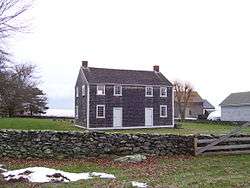
- Wilbor House Museum (1692)
- Little Compton Common Historic District
- United Congregational Church of Little Compton founded 1704, existing building dates to 1835
- Friends Meeting House and Cemetery (1815)
- Rhode Island Red Monument (1925)
- Sakonnet Light Station (1884)
- Stone House Inn (1854)
- William Whalley Homestead
References
- "U.S. Census website". United States Census Bureau. Retrieved January 31, 2008.
- "US Board on Geographic Names". United States Geological Survey. 2007-10-25. Retrieved January 31, 2008.
- "Little Compton Historical Society". Little Compton Historical Society.
- "Little Compton Historical Society".
- In Search of The Commons, part of A National Conversation Hosted by the Smithsonian and Arizona State University, Zoloco Public Square|.
- "Fort Church - FortWiki Historic U.S. and Canadian Forts". fortwiki.com. Retrieved 22 October 2015.
- "Annual Estimates of the Resident Population for Incorporated Places: April 1, 2010 to July 1, 2015". Archived from the original on June 2, 2016. Retrieved July 2, 2016.
- "Census of Population and Housing". Census.gov. Retrieved June 4, 2016.
- Snow, Edwin M. (1867). Report upon the Census of Rhode Island 1865. Providence, RI: Providence Press Company.
- U.S. Census Bureau (2018). American Community Survey 5-year estimates. Retrieved from Census Reporter Profile page for Little Compton town, Newport County, RI <http://censusreporter.org/profiles/06000US4400542400-little-compton-town-newport-county-ri/>
- "Sakonnet Point- Little Compton". Trails and Walks in Rhode Island.
- Little Compton Agricultural Conservancy Trust: History, Structure and How We Are Financed
- "Our School". web.archive.org. Archived from the original on 21 August 2006. Retrieved 18 October 2015.
- Rhode Island Red The Livestock Conservancy
- Wilbour, Benjamin Franklin (1967). Little Compton Families. Little Compton, RI: Little Compton Historical Society. p. xvii. ISBN 0-8063-4704-X.
- Schanen, Eric (October 2013). "Inside 'All is Lost' From a Trio of Cal 39s to Teaching Redford to Sail". Sailing Magazine. Retrieved 6 November 2013.
- Goodrich, David L. (2001). The Real Nick and Nora: Frances Goodrich and Albert Hackett, Writers of Stage and Screen Classics. Carbondale, IL: SIU Press. p. 8. ISBN 9780809389698.
- McGaw, Jim (July 16, 2012). "Little Compton Man's an Ambassador for the Arts". EastBayRI. Archived from the original on 29 May 2013. Retrieved 6 November 2013.
- Burdett, Bruce (April 16, 2013). "Henriette von Trapp, 85, Adamsville". EastBayRI. Archived from the original on 1 May 2013. Retrieved 6 November 2013.
External links
| Wikimedia Commons has media related to Little Compton, Rhode Island. |
| Wikivoyage has a travel guide for Little Compton. |
